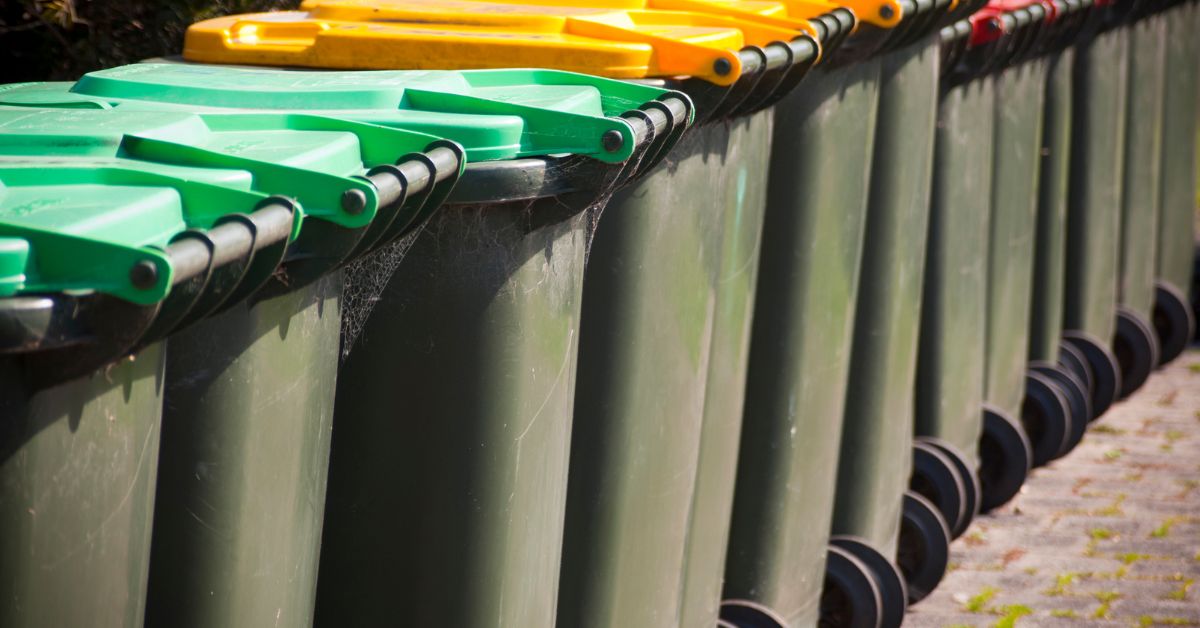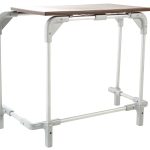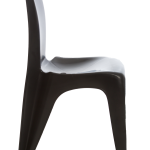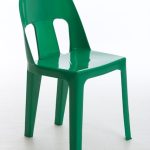Introduction
Commercial wheelie bins play a pivotal role in modern waste management systems, offering businesses a versatile and efficient way to collect, segregate, and dispose of waste. Their importance cannot be overstated, as they help maintain cleanliness, support recycling efforts, and ensure the effective management of waste materials. This guide aims to assist businesses in selecting and utilising the right wheelie bins for their specific needs, emphasising the significance of choosing the appropriate size, type, and features to optimise waste management practices and contribute to environmental sustainability.
Understanding Wheelie Bins
Definition and Basic Description:
Commercial wheelie bins are mobile waste containers designed for easy transportation and high durability. Typically equipped with a hinged lid and a pair of wheels, these bins are used by businesses and public institutions to manage waste and recycling materials efficiently.
Role in Effective Waste Management and Sustainability:
Wheelie bins play a crucial role in streamlining waste collection and segregation processes, facilitating recycling and reducing landfill waste. By enabling businesses to effectively manage their waste, wheelie bins contribute to sustainability goals and environmental protection efforts.
Types of Commercial Wheelie Bins
Overview of Different Types:
- General Waste Bins: For non-recyclable waste that goes to landfill.
- Recycling Bins: Often colour-coded to distinguish between paper, plastics, metals, and glass.
- Organic Waste Bins: Designed for compostable waste like food scraps and garden waste.
- Specialised Bins: For hazardous materials, medical waste, and other specific waste types requiring special handling.
Purposes and Discussion:
Each type of bin serves a specific purpose, from facilitating recycling efforts to safely disposing of hazardous materials, playing a critical role in comprehensive waste management strategies.
Sizes and Capacities
Choosing the Right Size and Capacity:
Commercial wheelie bins come in various sizes, commonly ranging from 120 litres to 1100 litres, to accommodate the varying waste management needs of businesses. The right size for your business depends on several factors, including the amount of waste generated, the frequency of waste collection services, and available space for bin storage.
Estimating Required Capacity:
Consider your business’s size, type, and daily operations to estimate the volume of waste produced. Restaurants, for example, might require larger or more frequent collections for organic waste, while offices may generate more paper waste.
Features and Materials
Materials Used in Manufacturing:
High-density polyethylene (HDPE) is a popular material for commercial wheelie bins due to its strength, durability, and resistance to environmental factors like UV light and extreme temperatures.
Key Features:
When selecting wheelie bins, look for features that enhance usability and longevity, such as robust wheels for easy movement, lockable lids to prevent unauthorised access or pest intrusion, and ergonomic designs that facilitate safe and comfortable handling.
Customisation Options
Customisation for Business Needs:
Wheelie bins offer various customisation options to meet specific business requirements, including colour coding for different waste streams, logo branding for corporate identity, and specialised lids for secure document disposal.
Importance of Colour Coding and Labelling:
Effective waste segregation is crucial for recycling and proper waste management. Colour coding and clear labelling help ensure that waste is disposed of in the correct bin, reducing contamination rates and improving recycling efficiency.
By understanding these key aspects of commercial wheelie bins, businesses can make informed decisions that not only improve their waste management practices but also support broader environmental sustainability goals. The right wheelie bins, chosen with careful consideration of a business’s specific needs and constraints, can significantly enhance the efficiency and effectiveness of waste management systems.
Safety and Handling
Best Practices for Safe Wheelie Bin Handling:
Safe handling of wheelie bins is essential to prevent injuries and ensure a safe workplace environment. Here are some best practices:
- Proper Lifting Techniques: Always push the bin in front of you, using your body weight to assist in movement, rather than pulling it. When lifting, bend at the knees, not the waist, to avoid back strain.
- Appropriate Footwear: Wear sturdy, non-slip shoes when moving bins to reduce the risk of slips, trips, and falls.
- Even Distribution of Waste: Ensure waste is evenly distributed within the bin to prevent it from becoming top-heavy and tipping over during movement.
Tips on Positioning and Moving Wheelie Bins:
- For Larger Capacities: Use a towing tug or a bin handling system for bins with larger capacities, especially when moving them over uneven surfaces or for long distances.
- Positioning for Collection: Place bins in a designated, easily accessible area for waste collection, ensuring they do not obstruct pathways or exits.
- Storing Bins: Store bins in a shaded, ventilated area to minimise exposure to direct sunlight and reduce the risk of material degradation or internal temperature increases that can lead to waste combustion.
Maintenance and Cleaning
Regular Maintenance and Cleaning Guidelines:
- Routine Inspections: Regularly inspect bins for damage, such as cracks or broken wheels, and arrange for repairs or replacements to maintain safety and functionality.
- Cleaning Schedule: Implement a regular cleaning schedule for bins to prevent the buildup of waste material and reduce odours. Use mild detergents and hot water for cleaning, and ensure bins are dry before use to prevent mould growth.
Dealing with Common Issues:
- Odours: Use baking soda or commercial odour neutraliser inside bins to manage unpleasant smells.
- Pests: Securely close lids to prevent access by pests. Consider using natural repellents, like vinegar or peppermint oil, around bin areas.
- Wear and Tear: Protect bins from excessive wear by avoiding overloading and ensuring they are not dragged over abrasive surfaces.
Environmental Considerations
Minimising Environmental Impact:
- Eco-friendly Materials: Choose wheelie bins made from recycled materials or those designed for long-term use to reduce environmental impact.
- Proper Waste Segregation: Implement effective waste segregation practices to facilitate recycling and reduce the amount of waste sent to landfills.
Enhancing Green Credentials through Effective Bin Management:
- Education and Training: Educate staff on proper waste management practices, emphasising the importance of recycling and waste reduction.
- Sustainable Practices: Encourage the use of compostable waste bins for organic waste to support composting efforts. Consider partnering with local recycling programs to ensure recyclable materials are processed correctly.
- Visibility: Promote your business’s commitment to sustainability by making your waste management and recycling efforts visible to customers and staff. This can include signage on bins that highlights your green practices or sharing your environmental policies publicly.
Implementing these safety, maintenance, and environmental considerations in your commercial wheelie bin management not only contributes to a safer, cleaner work environment but also supports your business’s sustainability goals. By focusing on eco-friendly practices, businesses can play a crucial role in promoting environmental responsibility and community well-being.
Purchasing Tips
When it comes to equipping your business with the right commercial wheelie bins, making an informed purchase is crucial. Here are essential factors to consider and tips on finding a reputable supplier:
Factors to Consider:
- Quality: Look for bins made from high-density polyethylene (HDPE) or other durable materials that can withstand rough handling, extreme weather conditions, and heavy loads. High-quality materials ensure a longer lifespan for your bins.
- Warranty: A good warranty can be a sign of the manufacturer’s confidence in their product. Look for warranties that cover a significant period and include coverage for common issues such as cracks, fading, and wheel damage.
- Supplier Reputation: Research suppliers thoroughly. Look for reviews, testimonials, and case studies from other businesses. A supplier with a positive reputation is likely to offer reliable products and excellent customer service.
- Compliance with Standards: Ensure the wheelie bins meet any relevant safety and environmental standards or certifications. This compliance not only guarantees the quality of the bins but also aligns with best practices in waste management.
- Customization Options: Consider whether the supplier offers customisation options that meet your specific waste management needs, such as colour coding, lid types, and branding.
Finding and Choosing a Reputable Supplier:
- Research: Start with an online search to create a list of potential suppliers. Look for companies with extensive experience in supplying commercial wheelie bins.
- Ask for Recommendations: Consult with industry peers or associations for supplier recommendations. First-hand experiences can provide valuable insights.
- Evaluate Their Offerings: Compare the products, services, and prices of various suppliers. Look for flexibility in order sizes, delivery options, and customer support services.
- Check References: Request and follow up on references or case studies from the supplier. This can give you a clearer picture of their reliability and the quality of their products.
Conclusion
Throughout this guide, we’ve explored the critical aspects of selecting and utilising commercial wheelie bins effectively. From understanding the different types, sizes, and features of wheelie bins to recognising the importance of safety, maintenance, and environmental considerations, it’s clear that the right wheelie bins can significantly enhance your waste management practices.
The choice of commercial wheelie bins should align with your business’s specific needs, sustainability goals, and operational requirements. By considering the factors outlined in the purchasing tips and choosing a reputable supplier, you can ensure that your investment in commercial wheelie bins supports efficient waste management, workplace safety, and environmental responsibility.
In conclusion, commercial wheelie bins are more than just containers for waste; they are a fundamental component of a modern, responsible business’s operations. Properly selected and managed, they contribute to a cleaner environment, enhance public health, and reflect your business’s commitment to sustainability. As we move towards a future where waste management and environmental stewardship become increasingly crucial, investing in the right commercial wheelie bins is a step in the right direction for any business aiming to make a positive impact. Contact us today!








